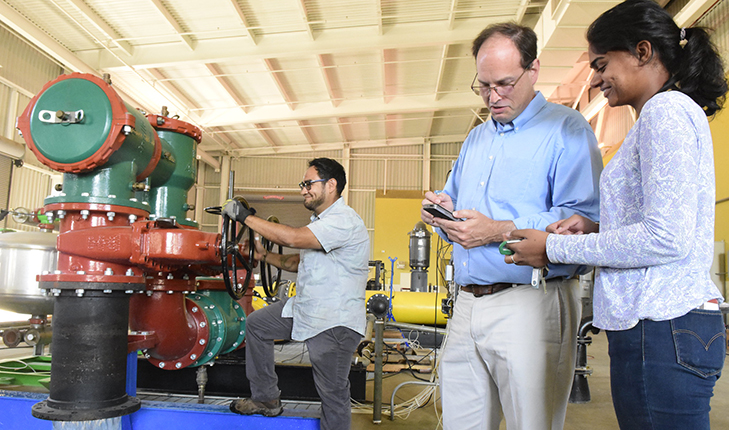New campus Center for Irrigation Technology director Dr. Charles Hillyer arrived on campus from Amarillo, Texas on Sept. 23, but his familiarity with the Central Valley goes back to 2005 while working as a graduate research assistant at Oregon State University.
Working on an irrigation management model, he visited the CIT website for information to improve sprinkler efficiency related to his project. The research center’s free and easy access to information was impressive and since then, Hillyer has continued to reference the site and the center’s staff over and over again. He has always been impressed.
That shared reliance on data is reflective of a new breed of irrigation specialists who are leading the field into the future with their computer and interconnectivity knowledge.
The Mississippi Gulf Coast native shifted his career focus to irrigation a decade ago when economics came into play. Needing to fund the final year of his doctorate, he found a job developing software for a USDA-funded irrigation project led by Oregon State professor emeritus Marshall English.
“It was a big change,” said Hillyer, “yet everything just clicked. I liked how irrigation was applied, relevant and interesting and still used my math and computer skills. Automation, information, sustainability and the need to save every last penny are tightly intertwined, especially in the water and energy management field.”
After getting his Ph.D. in 2011, he spent seven years using those skills as an assistant professor and researcher at Oregon State and Texas A&M Agrilife Research and Extension Service in Amarillo. In addition to working with Texas farmers in the North Plains, he also worked on the Precision Ag Irrigation Language, a data exchange standard that helps irrigation technologies work together better.
The seeds for his career choice came as an undergraduate agricultural and biological engineering student at Mississippi State University where he also worked as a student computer lab administrator. In graduate school, Hillyer was a graduate research assistant at the USDA Agricultural Research Service where he focused on applying simulation methods to a cotton production model.
Since April 2018, Hillyer has served as chief technical officer for Irrigation For the Future, a company that develops advanced tools, training and support for optimum irrigation management. That company works with Central Valley farmers to reduce water irrigation uncertainty and is funded partly by a grant from the California Energy Commission (CEC) to commercialize software that Hillyer developed while at Oregon State.
“CIT’s relationship with innovative and emerging companies is one of the things that most impressed me,” said Hillyer. “The campus Water, Energy and Technology (WET) Center, BlueTechValley and the Valley Ventures programs are helping start-up companies like the one I was with to be successful with water- and energy-saving technology products and services. A lot of these companies have great ideas, but they need some help in areas that might be less familiar like entrepreneurship, networking and client and product support. That partnership and knowledge gives the company a foundation and direction to grow and hopefully thrive.”
In addition to its innovation emphasis, CIT has also been a nationally-respected leader for almost 40 years for its independent hydraulics and pump testing laboratories, applied and field research facilities and educational programs. The center is tightly connected to the public and private sectors to advance irrigation technology, water and energy management practices and equipment standards.
“California is the place to be in the irrigation field,” Hillyer said. “It produces so many different commodities that have such different individual needs. The availability, need and delivery of water to the public and environment is complex and needs a long-term focus. There’s also an industry and community commitment to sustainability and new shared public policy-making that is unique.”
CIT clients will be able to use his 20 years of software system experience, more than half of which has focused on irrigation management and deficit irrigation tools.
Hillyer has also been connected to the public sector through his work with various committees in the American Society of Agricultural and Biological Engineers, Irrigation Association and the Environmental Water Resources Institute. He has also honed his communication skills by working with the Irrigation Today magazine editorial staff.
“State groundwater policies are coming to the forefront, and we can play a role in informing farmers, managers and policy makers on how these regulations will affect agriculture,” Hillyer said. “Those regulations will also require new documentation and recording tools, and CIT can support companies and farmers with useful products to provide accurate information.”
Hillyer is the fourth director of the center, replacing Sarge Green, who has served as interim director since January 2018. Past directors include Ed Norum (1980-85), Ken Solomon (1986-93) and David Zoldoske (1994-2017).






